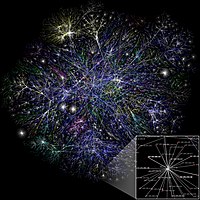
Photo from wikipedia
MOTIVATION Exploring the potential long noncoding RNA (lncRNA)-disease associations (LDAs) plays a critical role for understanding disease etiology and pathogenesis. Given the high cost of biological experiments, developing a computational… Click to show full abstract
MOTIVATION Exploring the potential long noncoding RNA (lncRNA)-disease associations (LDAs) plays a critical role for understanding disease etiology and pathogenesis. Given the high cost of biological experiments, developing a computational method is a practical necessity to effectively accelerate experimental screening process of candidate LDAs. However, under the high sparsity of LDA dataset, many computational models hardly exploit enough knowledge to learn comprehensive patterns of node representations. Moreover, although the metapath-based GNN has been recently introduced into LDA prediction, it discards intermediate nodes along the meta-path and results in information loss. RESULTS This paper presents a new multi-view contrastive heterogeneous graph attention network (GAT) for lncRNA-disease association prediction, MCHNLDA for brevity. Specifically, MCHNLDA firstly leverages rich biological data sources of lncRNA, gene and disease to construct two-view graphs, feature structural graph of feature schema view and lncRNA-gene-disease heterogeneous graph of network topology view. Then, we design a cross-contrastive learning task to collaboratively guide graph embeddings of the two views without relying on any labels. In this way, we can pull closer the nodes of similar features and network topology, and push other nodes away. Furthermore, we propose a heterogeneous contextual GAT, where long short-term memory network is incorporated into attention mechanism to effectively capture sequential structure information along the meta-path. Extensive experimental comparisons against several state-of-the-art methods show the effectiveness of proposed framework.The code and data of proposed framework is freely available at https://github.com/zhaoxs686/MCHNLDA.
Journal Title: Briefings in bioinformatics
Year Published: 2022
Link to full text (if available)
Share on Social Media: Sign Up to like & get
recommendations!